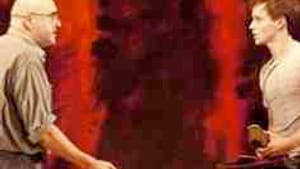Stay in the Loop
BSR publishes on a weekly schedule, with an email newsletter every Wednesday and Thursday morning. There’s no paywall, and subscribing is always free.
How art happens
John Logan's "Red': Mark Rothko on Broadway

Red is a play about painting, about color, about making art. It's especially about Mark Rothko (1903-1970), one of the 20th Century's most revered painters— the towering Abstract Expressionist who, along with Jackson Pollock, "stomped the Cubists to death." It's a play about artistic passion; as Rothko will shout at his young assistant, Ken: "I am here to stop your heart…. I am here to make you think…. I am not here to make pretty pictures!"
John Logan's play, under Michael Grandage's powerful direction, solves the almost insoluble problem of how to show a painter painting— how to reveal onstage how the making of art happens. Rothko's huge color field paintings of his red and black period stand before us, hauled up on a pulley, leaning against a wall, immense presences. "There's tragedy in every brush stroke." We are asked to look.
Our looking benefits from guidance from the artist himself: The first half hour of Red is a really a lecture about art, delivered by the subject. The play covers the two years during which Rothko created the paintings for a commissioned mural for the new Four Seasons restaurant that opened in 1959 in the Seagram Building on Park Avenue in New York. Rothko imagined it would be "like a chapel… A place of communion." But as Ken points out, "It's a restaurant."
Of course the chapel— specifically Rothko's paintings for the Houston Chapel— would come later. What happened to the Seagram mural project is the plot, more or less, mostly less, of the play.
Designer's challenge
Such a play"“ about art, about paintings, about a painter obsessed with light (Rothko scorned natural light)— is necessarily a challenge to the design team. Neil Austin's lighting design keeps the stage in superb semi-gloom, although I could have done without the painting-illuminated-from-within-effect to show the effect Rothko was after. Christopher Oram provides the fascinating set, dripping with red, full of grisly energy.
This production, transferred from the Donmar Warehouse in London, brings to Broadway the original cast: Alfred Molina as Rothko and Eddie Redmayne as his young assistant.
Red doesn't really catch theatrical fire until we're well into this 90-minute show— specifically, when Ken finally reveals not only some of his (unnecessarily lurid) back-story, but also defies Rothko's opinions, declaring that just as the Abstract Expressionists replaced the Cubists and the Surrealists— Cézanne and Dali swept away with one scornful gesture— so the Pop Artists are replacing Rothko.
Rothko will definitely not go gently into that good night of the passé, bested by "comic books and soup cans." At this point, finally, Rothko and Ken become characters rather than talking heads, and we respond to them as people, not merely as critical positions.
Rothko's epitaph
"Without monsters and gods," Rothko once remarked, long before this play's time frame, "art cannot enact our drama." He should know, having been both. This is a daring play that shows us what a monster of self-absorption and narcissistic contempt our god can be. Rothko's life, both biographically and artistically, constituted a study in how "black swallows red"; the paintings showcased in Red would yield eventually to the final black canvases. And Rothko committed suicide in 1970, leaving a floor covered with red blood.
Another old Rothko line seems particularly apt here: "I think of my pictures as dramas; the shapes in the pictures as performers." The pictures and their shapes, like the play and its actors, give us a big glimpse into something serious and important.
John Logan's play, under Michael Grandage's powerful direction, solves the almost insoluble problem of how to show a painter painting— how to reveal onstage how the making of art happens. Rothko's huge color field paintings of his red and black period stand before us, hauled up on a pulley, leaning against a wall, immense presences. "There's tragedy in every brush stroke." We are asked to look.
Our looking benefits from guidance from the artist himself: The first half hour of Red is a really a lecture about art, delivered by the subject. The play covers the two years during which Rothko created the paintings for a commissioned mural for the new Four Seasons restaurant that opened in 1959 in the Seagram Building on Park Avenue in New York. Rothko imagined it would be "like a chapel… A place of communion." But as Ken points out, "It's a restaurant."
Of course the chapel— specifically Rothko's paintings for the Houston Chapel— would come later. What happened to the Seagram mural project is the plot, more or less, mostly less, of the play.
Designer's challenge
Such a play"“ about art, about paintings, about a painter obsessed with light (Rothko scorned natural light)— is necessarily a challenge to the design team. Neil Austin's lighting design keeps the stage in superb semi-gloom, although I could have done without the painting-illuminated-from-within-effect to show the effect Rothko was after. Christopher Oram provides the fascinating set, dripping with red, full of grisly energy.
This production, transferred from the Donmar Warehouse in London, brings to Broadway the original cast: Alfred Molina as Rothko and Eddie Redmayne as his young assistant.
Red doesn't really catch theatrical fire until we're well into this 90-minute show— specifically, when Ken finally reveals not only some of his (unnecessarily lurid) back-story, but also defies Rothko's opinions, declaring that just as the Abstract Expressionists replaced the Cubists and the Surrealists— Cézanne and Dali swept away with one scornful gesture— so the Pop Artists are replacing Rothko.
Rothko will definitely not go gently into that good night of the passé, bested by "comic books and soup cans." At this point, finally, Rothko and Ken become characters rather than talking heads, and we respond to them as people, not merely as critical positions.
Rothko's epitaph
"Without monsters and gods," Rothko once remarked, long before this play's time frame, "art cannot enact our drama." He should know, having been both. This is a daring play that shows us what a monster of self-absorption and narcissistic contempt our god can be. Rothko's life, both biographically and artistically, constituted a study in how "black swallows red"; the paintings showcased in Red would yield eventually to the final black canvases. And Rothko committed suicide in 1970, leaving a floor covered with red blood.
Another old Rothko line seems particularly apt here: "I think of my pictures as dramas; the shapes in the pictures as performers." The pictures and their shapes, like the play and its actors, give us a big glimpse into something serious and important.
What, When, Where
Red. By John Logan; directed by Michael Grandage. Through June 27, 2010 at John Golden Theater, 252 West 45th St., New York. (212) 239-6200 or (800) 432-7250 or www.newyorkcitytheatre.com.
Sign up for our newsletter
All of the week's new articles, all in one place. Sign up for the free weekly BSR newsletters, and don't miss a conversation.

 Toby Zinman
Toby Zinman